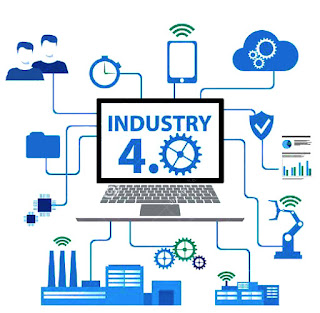In this article we will discuss the History of the Fourth industrial revolution, what is Industry 4.0 and how is it going to enhance the future of Industries?
"An Industrial Revolution can be considered as a system of macro inventions that generates events that change the world in a definitive and pragmatic way, regardless of the supporting scientific basis."
The concept of the Fourth Industrial Revolution was coined
in 2016 by Klaus Schwab, the founder of the World Economic Forum, In
his book The fourth industrial revolution.
"The Fourth Industrial Revolution creates a world in which virtual and physical systems of manufacturing cooperate with each other in a flexible way at the global level"
A brief history of Four Industrial revolution
What is Industry 4.0?
Industry 4.0 is the fancy name for the 4
Industry 4.0 is the artificial intelligence, integration of data, machinery, and communication to create an efficient technological advancement that is not just automated but intelligent.
Nine Pillars of Industry 4.0
Industry 4.0 includes an extensive set of technologies, which
is also called the Nine Pillars of Industry 4.0. Integration of these technologies
is going to enhance the future of industries. Let’s discuss the same.
1. ADDITIVE MANUFACTURING:-
Additive manufacturing like 3-D
printing is being widely used in Industrial 4.0. They can be used to produce
prototypes & smaller parts of machines. Customized, complex, and lightweight
designs can be achieved. They are widely used by the aerospace industry to lighten
their aircraft, to reduce fuel consumption.
2. AUGMENTED REALITY:-
Augmented reality analyses the existing environment and adds information
to it for establishing a new artificial environment. This artificial
environment is widely used in industries like healthcare and automotive for
real-world computer simulations. In the Upcoming time, organizations will make
much broader use of AR to provide workers with real-time information to improve
work procedures and decision-making.
3. AUTONOMOUS ROBOTS:-
Since industrial 3.0, robots were widely used to tackle complex
assignments, but they are evolving for a greater utility. Robots are becoming
more autonomous, pliable, and collaborative. They will communicate with each
other and work cognitively & safely with mankind. These robots and
analytics chatbots will be cost-effective and have a more brilliant range
of abilities than those used in manufacturing today.
4. BIG DATA AND ANALYTICS:-
The emergence of large data sets in industries opened the way for big data
analytics. The focus is to optimize production quality, save power, and
improvement of equipment and its services. The objective is to gather data from
most of the sources involved in manufacturing and correlate the captured
and processed data. Improving failures and customer relations for making
informed business decisions.
5. CLOUD COMPUTING:-
In
the present scenario, cloud technology goes way beyond scalability, speed, cost
efficiencies, and storage. It gives the foundation for the most advanced
technologies – from AI and ML to the IoT – and provides organizations with a
way to organize. Smart factories with the increased manufacturing-affiliated
operation will require more data sharing across organizations and their employees
and customers. System information and its operation once employed in the cloud
will allow increased data-driven operations for manufacturing stations.
6. CYBER SECURITY:-
With the advancement and standardization
of cyber technologies, there is a need for the protection of information and data.
It ensures shielding from theft or provides shelter to overcome harm to the
software, hardware, and electronic data. The smart industry predominantly based
on communication and networking protocols will majorly rely on cyber security
for its safety.
7. HORIZONTAL AND VERTICAL SYSTEM INTEGRATION:-.
Currently,
most of the IT systems are not fully integrated. Organizations, customers, and
suppliers are rarely closely linked. Functions in the organization are not
fully integrated. From plants to products to automation—lacks complete
integration.
But with Industry 4.0, organizations, functions,
departments, and capabilities will become much more tenacious, as
cross-organization, and universal data-integration networks evolve and enable a truly
automated value chain.
8. INTERNET OF THINGS:-
The Internet of Things, or IT, refers to the
billions of physical devices around the world that are now connected to the
internet, collecting and sharing data. With the help of research processors and
wireless networks, it's possible to turn anything, from a pill to an airplane
to a self-driving car into part of the IT. Examples of IT include self-driving
trucks, home automation, Car2Car Communication, Smart health tracking devices, smart city projects, etc.
9. SIMULATION:-
Every physical problem in a product can be
represented in the form of a computational model. This type of model is
simulated to moderate the failure in the final product. The need for the physical
test has been reduced with the embarking of simulation technology. Simulation
techniques like Computational fluid dynamics, Finite Element Analysis, thermal
simulation, and digital and analog simulation had saved millions of dollars for
industries.
We will discuss each pillar of Industry 4.0 in detail, in my upcoming blogs.
Thanks for taking the time to read this article. How this trending technology will help you in your workplace? Share your thoughts in the comment section.
If you like my blog, Don't keep this to yourself.
If you want to continually improve your knowledge, and enhance your career then follow me on telegram and Facebook.


~3.jpg)


0 Comments